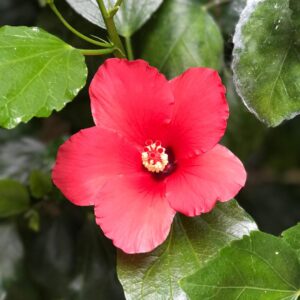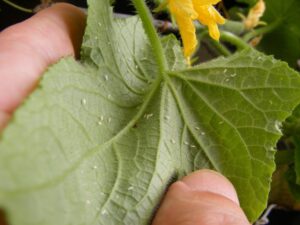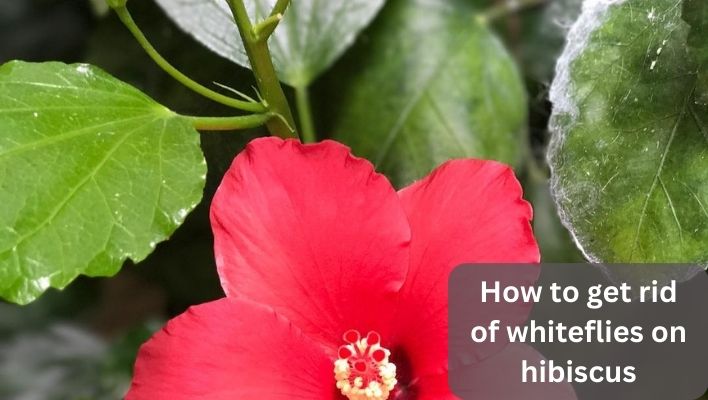Are you struggling to keep your hibiscus plants healthy and free of whiteflies? These tiny, sap-sucking insects can quickly wreak havoc on your beloved hibiscus plants, causing stunted growth, yellowing leaves, and even death in severe cases.
But don’t worry – there are several effective methods for removing whiteflies on hibiscus plants. In this article, we’ll cover everything you need to know about identifying, preventing, and treating whitefly infestations on hibiscus. Whether you prefer natural remedies or chemical insecticides, we’ve covered you with step-by-step instructions and tips for success. So let’s dive in and banish those pesky whiteflies for good!
Identifying Whiteflies on Hibiscus
Whiteflies are tiny, sap-sucking insects that belong to the family Aleyrodidae. They are typically found on the undersides of hibiscus leaves, feeding on the plant’s sap and excreting a sticky, sugary substance known as honeydew.
Adult whiteflies are small, moth-like insects about 1/16 to 1/8 inch long. They have white wings and yellowish bodies. When disturbed, they will flutter around the plant and quickly return to their original location.
Whitefly eggs are tiny and difficult to see with the naked eye. They are usually laid on the underside of the leaves in clusters of 20 to 30. Once the eggs hatch, the immature whiteflies, known as nymphs, will begin feeding on the sap of the hibiscus plant.
If you suspect that your hibiscus plant has a whitefly infestation, carefully inspect the undersides of the leaves for signs of adult whiteflies, nymphs, and eggs. You may also notice sticky honeydew on the leaves or a black, sooty mold that grows on the honeydew.

The Damage Whiteflies Cause
Whiteflies can cause significant damage to hibiscus plants, both by feeding on the plant’s sap and by transmitting plant viruses. Some of the most common symptoms of whitefly damage on hibiscus plants include:
- Stunted Growth: Whiteflies feed on the sap of the hibiscus plant, which can cause the plant to grow more slowly than it normally would. This can result in stunted growth and smaller overall plant size.
- Yellowing Leaves: As whiteflies continue to feed on the hibiscus plant, they can cause the leaves to turn yellow or brown. This can be especially noticeable on newer leaves.
- Leaf Drop: In severe cases of whitefly infestation, the hibiscus plant may begin to drop its leaves prematurely. This can indicate that the plant is stressed and lacking nutrients.
- Sooty Mold: Whiteflies excrete a sticky, sugary substance called honeydew. This can attract other insects and lead to the growth of a black, sooty mold on the leaves of the hibiscus plant.
- Plant Virus Transmission: Some species of whiteflies are known to transmit plant viruses, which can cause even more damage to hibiscus plants.
If left unchecked, whitefly infestations can severely damage hibiscus plants and even lead to their death. That’s why it’s important to take action as soon as you notice any signs of whiteflies on your hibiscus plant.
- Targets and kills aphids, beetles (Leaf-feeding), caterpillars (Leaf-feeding), crickets, earwigs, lace bugs, leafhoppers, mealybugs, mites, plant bugs, scale crawlers, thrips and whiteflies
- Controls and kills powdery mildew, black spot, leaf spot, and rust
- Organic formula ideal for use around children, pets, and wildlife.
Natural Remedies for Whiteflies
If you’re looking for a natural way to control whiteflies on your hibiscus plant, there are several remedies you can try:
Introduce Natural Predators:
Ladybugs and lacewings are natural predators of whiteflies and can help to control their population. You can purchase these insects at many garden supply stores and release them onto your hibiscus plant.
Use Neem Oil:
Neem oil is a natural insecticide that can help to control whiteflies on hibiscus plants. Mix one tablespoon of neem oil with one teaspoon of dish soap and one quart of water. Spray the mixture onto the undersides of the hibiscus leaves, making sure to cover all areas. Repeat every week until the whitefly population is under control.
Spray with Soapy Water:
Soapy water can be an effective way to control whiteflies on hibiscus plants. Mix one tablespoon of dish soap with one quart of water and spray the mixture onto the undersides of the hibiscus leaves. This will suffocate the whiteflies and prevent them from feeding on the plant. Repeat every few days until the whitefly population is under control.
Use Sticky Traps:
Sticky traps are another natural way to control whiteflies on hibiscus plants. Hang yellow sticky traps near the hibiscus plant to attract and trap the whiteflies. You can purchase these traps at many garden supply stores.
Use Reflective Mulch:
Reflective mulch can be placed around the base of your hibiscus plant to reflect sunlight onto the undersides of the leaves, making it less attractive for whiteflies to lay their eggs.
When applying natural remedies to remove whiteflies on your hibiscus plant, following the instructions carefully and being patient is important. Natural remedies may take longer to show results than chemical pesticides, but they can be just as effective in the long run.
When applying natural remedies to control whiteflies on hibiscus plants, it’s important to follow these steps:
- Test the remedy on a small hibiscus plant area first to ensure it doesn’t cause any damage.
- Apply the remedy in the early morning or late afternoon when the hibiscus plant is not in direct sunlight.
- Make sure to cover all areas of the hibiscus plant, especially the leaves’ undersides where whiteflies congregate.
- Repeat the treatment as necessary until the whitefly population is under control.
Chemical Treatments for Whiteflies
If natural remedies don’t effectively control whiteflies on your hibiscus plant, consider using chemical treatments. Here are some of the most common chemical treatments for whiteflies on hibiscus:
- Insecticidal Soap: Insecticidal soap is a low-toxicity pesticide that effectively controls whiteflies on hibiscus plants. To use insecticidal soap, dilute the solution according to the manufacturer’s instructions and spray it on the affected leaves, covering both the tops and undersides of the leaves.
- Neonicotinoids: Neonicotinoids are a type of systemic pesticide that can be applied to the soil around the base of the hibiscus plant. The pesticide is absorbed by the roots and distributed throughout the plant, effectively controlling whiteflies and other pests.
- Pyrethroids: Pyrethroids are a type of synthetic pesticide that can effectively control whiteflies on hibiscus plants. Pyrethroids should be applied to the affected leaves according to the manufacturer’s instructions, covering both the leaves’ tops and undersides.
When applying chemical treatments to remove whiteflies on your hibiscus plant, it’s important to wear protective clothing and follow the instructions carefully. Be sure to apply the pesticide only as directed, and avoid overuse, as this can lead to pesticide resistance. Additionally, always store pesticides out of reach of children and pets.
Top Pesticides for Whiteflies
Southern Ag Natural Pyrethrin Concentrate
If you are looking for the best pesticides for whiteflies, one option you could consider is Southern Ag Natural Pyrethrin Concentrate. This product is made from a natural insecticide called pyrethrin derived from the chrysanthemum flower.
It can effectively control whiteflies and other pests and is also considered a low-toxicity option for humans and pets. However, it’s important to always read and follow the label instructions carefully when using any pesticide product.
Additionally, you may want to consider using other methods in conjunction with pesticide treatment, such as physically removing whiteflies or encouraging natural predators like ladybugs.
Safer Brand 3-in-1 32-Ounce Ready-to-Use Garden Spray
Another option for controlling whiteflies is Safer Brand 3-in-1 32-Ounce ready-to-use garden spray. This product is designed to control various pests, including whiteflies, fungal diseases, and mites.
It contains natural ingredients such as sulfur and pyrethrins, which can effectively control pests while being safer for the environment and non-target organisms. It is also a ready-to-use spray, meaning you don’t have to mix anything before applying it to your plants.
BioAdvanced 3-in-1 Insect Disease and Mite Control
BioAdvanced 3-in-1 Insect Disease and Mite Control is another product for controlling whiteflies. It is a systemic insecticide, which means the plant absorbs it and provides protection from the inside out.
It is designed to control various pests, including whiteflies, diseases, and mites. However, it is important to note that this product contains neonicotinoids, which have been linked to negative effects on bee populations.
Therefore, it is important to use this product cautiously, follow the label instructions carefully, and avoid application when bees are actively foraging.
Additionally, it’s always a good idea to explore non-chemical methods for pest control, such as physically removing whiteflies or encouraging natural predators like ladybugs.
Preventing Whiteflies
Preventing whiteflies from infesting your hibiscus plants is the best way to avoid the damage they can cause. Here are some tips for preventing whitefly infestations on your hibiscus plants:
- Regular Pruning: Pruning your hibiscus plant regularly can help prevent whitefly infestations. Remove any damaged or infected leaves, as well as any leaves that are touching the ground. This will help improve air circulation and make it harder for whiteflies to lay their eggs.
- Use Companion Planting: Some plants, such as marigolds and petunias, are natural repellents for whiteflies. Consider planting these companion plants around your hibiscus to help prevent whitefly infestations.
- Avoid Over-Fertilization: Whiteflies are attracted to plants that are over-fertilized. Be sure to follow the recommended fertilization schedule for your hibiscus plant and avoid over-fertilization.
- Maintain Good Hygiene: Whiteflies are attracted to dirty, dusty plants. Regularly clean your hibiscus plant by wiping the leaves with a damp cloth or gently spraying them with water. This will help prevent whiteflies from infesting your plant.
- Use Yellow Sticky Traps: Yellow sticky traps can be placed around the base of your hibiscus plant to trap whiteflies. The traps are coated with a sticky substance that attracts the insects, and once they land on the trap, they can’t escape.
By following these tips, you can help prevent whitefly infestations on your hibiscus plants and keep them healthy and vibrant.
Maintenance and Monitoring
After successfully getting rid of whiteflies on your hibiscus plants, continuing with ongoing maintenance and monitoring is important to prevent their return. Here are some tips for ongoing maintenance and monitoring:
- Regular Inspections: Inspect your hibiscus plant regularly for any signs of whiteflies, such as sticky residue or tiny white insects on the undersides of leaves. Catching an infestation early can help prevent it from spreading and causing damage to your plant.
- Proper Watering: Hibiscus plants must be watered properly to remain healthy and strong. Overwatering or underwatering your plant can weaken it, making it more susceptible to whitefly infestations. Follow the recommended watering schedule for your hibiscus plant.
- Remove Infected Leaves: If you notice any leaves on your hibiscus plant that are infected with whiteflies, remove them immediately. This will prevent the infestation from spreading to other parts of the plant.
- Regular Cleaning: Regularly clean your hibiscus plant by wiping the leaves with a damp cloth or gently spraying them with water. This will help prevent the buildup of dust and dirt, which can attract whiteflies.
Following these ongoing maintenance and monitoring tips, you can help ensure that whiteflies do not return to your hibiscus plants and keep them healthy and vibrant.

How to get rid of whiteflies on hibiscus FAQs
How often should I monitor my hibiscus plants for whiteflies?
It’s recommended that you monitor your hibiscus plants for whiteflies at least once a week during the growing season and even more frequently if you have had a whitefly problem. Regular monitoring can help you catch an infestation early and prevent it from spreading.
How do I know if my hibiscus plant has a whitefly infestation?
Signs of a whitefly infestation on hibiscus plants include sticky residue on leaves and tiny white insects on the undersides of leaves. You may also notice stunted growth, yellowing leaves, and leaf drop.
Are chemical insecticides safe for use on hibiscus plants?
Some chemical insecticides can be used safely on hibiscus plants to control whiteflies. Still, following the instructions carefully is important and using only insecticides labeled safe for hibiscus plants. Always wear protective clothing and follow safety precautions when using any chemical insecticides.
How can I prevent future whitefly infestations on my hibiscus plants?
You can prevent future whitefly infestations on your hibiscus plants by practicing good gardening techniques, such as regular pruning, avoiding over-fertilization, using companion planting, and proper watering. You can also introduce natural predators to your garden, such as ladybugs and lacewings, which can help keep whiteflies under control. Regularly monitoring your hibiscus plants can also help catch any infestations early and prevent them from spreading.
Conclusion
In conclusion, whiteflies can cause significant damage to hibiscus plants, including stunted growth, yellowing leaves, and leaf drop. It’s essential to identify whiteflies early and take steps to control their populations.
Natural remedies, such as introducing natural predators and using neem oil, can effectively control whiteflies. Chemical treatments can also be used, but it’s important to use them safely and follow instructions carefully.
Preventative measures like regular pruning and companion planting can help prevent future infestations. Ongoing maintenance and monitoring are essential to ensure whiteflies do not return to your hibiscus plants. Following these tips can help keep your hibiscus plants healthy and beautiful.




